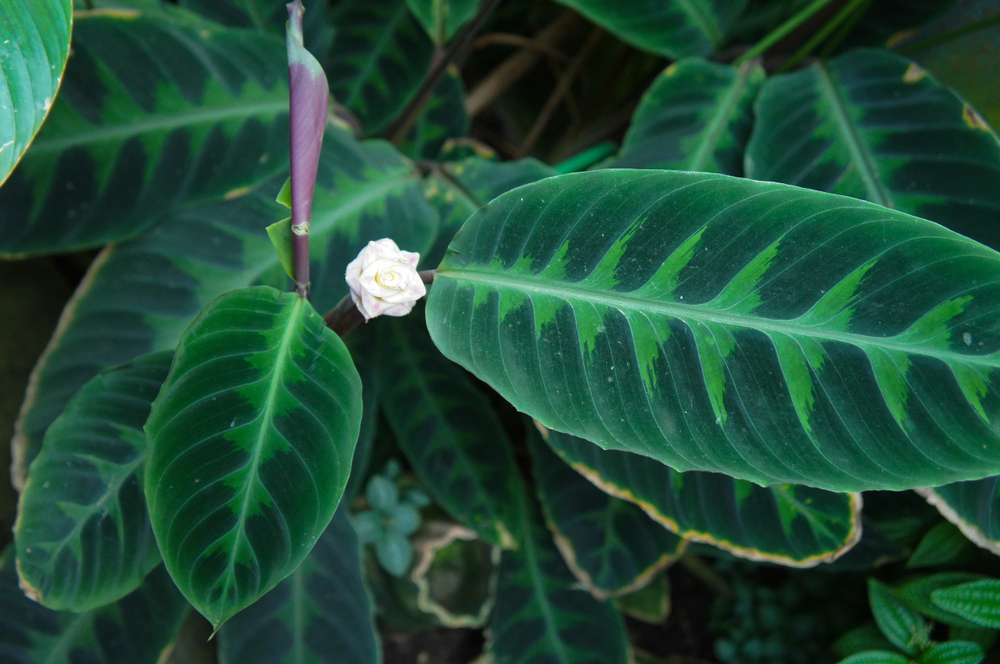Calathea
(Goeppertia cardenasii)

Description
Goeppertia cardenasii, commonly known as the Calathea cardenasii, is an enchanting plant that belongs to the Marantaceae family. Native to the tropical rainforests of Ecuador and Peru, this perennial herbaceous species has captured the attention of plant enthusiasts and collectors worldwide. Renowned for its stunning foliage and unique growth habits, Goeppertia cardenasii has become a popular choice for indoor gardening, adding elegance and vibrancy to any space. In this article, we will explore the various aspects of Goeppertia cardenasii, including its taxonomy, morphology, habitat, cultivation, and care requirements. Taxonomy Goeppertia cardenasii was previously classified under the genus Calathea, but recent taxonomic revisions have resulted in its reclassification. The genus Goeppertia now encompasses several former Calathea species. The plant is scientifically named after Dr. Enrique Cardenas, a renowned Peruvian botanist who extensively studied the flora of the region. Physical Appearance Goeppertia cardenasii boasts exquisite foliage that contributes to its widespread popularity. The plant features elongated lanceolate leaves with prominent parallel veins, creating an appealing feather-like appearance. The upper leaf surface is characterized by a deep green coloration, while the undersides showcase contrasting burgundy hues. The leaf edges are often fringed, further adding to the plant's ornamental value. Goeppertia cardenasii is a compact species, reaching a height of around 30 to 60 centimeters (12 to 24 inches). Habitat and Distribution Goeppertia cardenasii is endemic to the rainforests of Ecuador and Peru. Within this region, it predominantly thrives in the understory of the forest floor, where it benefits from the filtered light that permeates through the dense foliage above. The plant is adapted to the tropical climate of its native habitat, which is characterized by high humidity and consistent temperatures. These conditions play a crucial role in maintaining the health and vitality of Goeppertia cardenasii. Cultivation Cultivating Goeppertia cardenasii can be a rewarding experience for plant enthusiasts. However, it requires careful attention to specific cultivation requirements to ensure its optimal growth. Light: Goeppertia cardenasii thrives in bright, indirect light. It is essential to shield the plant from direct sunlight, as it can scorch the leaves. Placing the plant near a north or east-facing window where it can receive filtered sunlight is ideal. Temperature: Goeppertia cardenasii prefers temperatures ranging between 18°C to 24°C (64°F to 75°F). Avoid exposing the plant to sudden temperature fluctuations, drafts, or cold air, as these can cause stress and lead to leaf damage. Humidity: Being a tropical plant, Goeppertia cardenasii requires high humidity levels to thrive. Mist the plant regularly or use a humidifier to create a humid microclimate around it. Placing the plant on a tray filled with water and pebbles can also help elevate humidity levels. Watering: It is crucial to maintain consistent moisture levels for Goeppertia cardenasii. Keep the soil evenly moist, but not waterlogged. Overwatering can lead to root rot, while underwatering can cause the leaves to curl and dry out. Use filtered or distilled water to avoid the buildup of salts and minerals that can harm the plant. Soil and Potting: Goeppertia cardenasii thrives in well-draining, fertile soil. A mixture of peat moss, perlite, and high-quality potting soil is recommended. This combination provides adequate drainage while retaining enough moisture for the plant's roots. When repotting, choose a pot that allows for future growth and has drainage holes to prevent waterlogging. Fertilization: Goeppertia cardenasii benefits from regular feeding during the growing season, from spring to summer. Use a balanced, water-soluble fertilizer formulated for houseplants, diluted to half the recommended strength, and apply it every two to four weeks. During the dormant season, reduce or suspend fertilization. Propagation: Propagating Goeppertia cardenasii can be done through division or stem cuttings. Division involves separating the plant into smaller clumps, ensuring each division has healthy roots. Stem cuttings can be taken from mature stems with at least two to three nodes. Place the cuttings in a well-draining rooting medium and provide high humidity until roots develop. Pests and Diseases: Goeppertia cardenasii is relatively resistant to pests, but it can occasionally be affected by common houseplant pests such as spider mites, mealybugs, or aphids. Regularly inspect the leaves and stems for signs of infestation and promptly treat any issues with appropriate organic or chemical remedies. Ensure good airflow and avoid overcrowding to minimize the risk of fungal diseases. Conclusion Goeppertia cardenasii, with its captivating foliage and unique growth habits, is a captivating addition to any indoor garden. Its lush green leaves with burgundy undersides make it a visual delight, while its relative ease of care adds to its appeal. With the right conditions of light, temperature, humidity, and watering, Goeppertia cardenasii can flourish and bring a touch of the tropical rainforest into your home. By understanding and meeting its specific cultivation requirements, plant enthusiasts can enjoy the beauty and grace of Goeppertia cardenasii for years to come.
Taxonomic tree:







